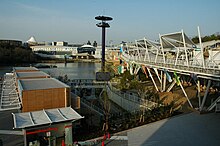Aichi Expo
| EXPO Nagoya 2005 | |
|---|---|

A part of the Global Loop at Expo 2005
|
|
| Overview | |
| BIE-class | Specialized exposition |
| Category | International specialized exposition |
| Name | Ai-chikyūhaku (愛・地球博) |
| Motto | Nature's Wisdom |
| Area | 173 hectares (430 acres) |
| Invention(s) | ASIMO |
| Visitors | 22,049,544 |
| Participant(s) | |
| Countries | 121 |
| Organizations | 4 |
| Location | |
| Country | Japan |
| City | Nagoya |
| Venue | Seto and Nagakute |
| Coordinates | 35°10′34.2″N 137°5′26.5″E / 35.176167°N 137.090694°E |
| Timeline | |
| Bidding | 1988 |
| Awarded | June 12, 1997 |
| Opening | March 25, 2005 |
| Closure | September 25, 2005 |
| Specialized expositions | |
| Previous | Expo '98 in Lisbon |
| Next | Expo 2008 in Zaragossa |
| Universal expositions | |
| Previous | Expo 2000 in Hannover |
| Next | Expo 2010 in Shanghai |
| Horticultural expositions | |
| Previous | 2003 World Horticultural Exposition in |
| Next | Royal Flora Ratchaphruek in Chiang Mai |
Expo 2005 was the World's Fair held for 185 days between Friday, March 25 and Sunday, September 25, 2005, in Aichi Prefecture, Japan, east of the city of Nagoya. It was a Specialized International Exhibition under the scheme of the 1972 protocol of the Convention relating to International Exhibitions. Japan has also hosted Expo'70 Osaka (Universal International Exhibition), Expo '75 Okinawa (Special International Exhibition), Expo'85 Tsukuba (Specialized International Exhibition), and Expo'90 Osaka (Horticultural International Exhibition).
The theme of the Expo was "Nature's Wisdom", with national and corporate pavilions expressing themes of ecological co-existence, renewable technology, and the wonders of nature. In Japanese, this is rendered as Ai-chikyūhaku (愛・地球博), which means (roughly) "Love the Earth Expo," as well as being a play on the name of the host prefecture, 愛知 (Aichi). According to the official website:
The main site of the Expo was a forested area in Nagakute, east of Nagoya, covering an area of about 1.85 square kilometres (460 acres). A smaller area of 0.15 square kilometres (37 acres) nearby, accessible by gondola from the main site near Seto was also part of the Expo. Great care was taken to build the pavilions out of recycled or recyclable materials, to minimize environmental impact on the site, and to provide environmentally friendly transportation to and within the Expo area.
The cost of the Expo has been estimated at 340 billion yen ($3.3 billion). However, the recorded 22,049,544 visitors greatly exceeded the target of 15,000,000 and the Expo made a profit of over 10 billion yen.
The nearby city of Toyota also held some related events, although there was no special area set aside.
The area in Nagakute can be reached from Nagoya by subway (Higashiyama line) to the last stop in Fujigaoka, followed by a ride on the newly built Linimo magnetic levitation train.
...
Wikipedia
